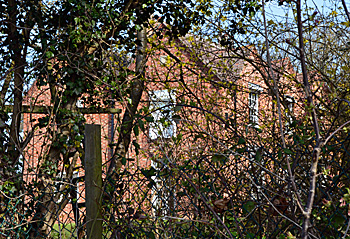Riseley Vicarages

The Old Vicarage seen through the hedge April 2015
The earliest description of the vicarage at Riseley comes in an archeaconry terrier of about 1700. This building had a thatched roof and comprised a great parlour, with a deal floor, a small parlour with an oak floor, a hall, kitchen, brewhouse and cellar all with brick floors and a buttery with an earth floor. Above were five chambers – two garrets, a study and two closets. A thatched great barn stood outside along with a smaller barn, two stables and a hogsty [ABE II (I page 328)]. It seems likely that the buildings were a century old by this date. The former vicarage was listed by the former Department of Environment in June 1974 as Grade II, of special interest, dating from the 18th century and so likely replaced the building described about 1700.
The vicarage was repaired between 1801 and 1828 and detailed rebuilding accounts survive in one of the parish registers [P50/1/5]. The 1828 repairs were by "experienced workman" from Riseley John Farrer as papers held at Lincolnshire diocesan archive tell us. The vicarage was altered again in 1878 as a date plaque on the house reveals.
The Rating and Valuation Act 1925 specified that every building and piece of land in the country was to be assessed to determine its rateable value. The valuer visiting the Vicarage [DV1/C215/117] found that it stood in 1.363 acres. Downstairs was a dining room, a drawing room, a kitchen (annotated "now morning room"), a pantry, a scullery (annotated "now kitchen"), a washhouse (annotated "now nursery and sometimes for scouts"), a study, a morning room (annotated "now study"), and a pantry. Upstairs were five double bedrooms, a bathroom and lavatory (in the sense of a place to wash rather than a toilet), two single bedrooms, a WC, an attic bedroom and a spare bedroom. Outside stood a garage, a lumber place with a loft over, a harness room used as a store, a three stall stable ("not used"), a potting shed, a coal house and wood house, 2 WCs and a summerhouse. There was a tennis court. The valuer commented: "Run as a sort of boarding house".
In 1975 the church applied for planning permission to build a new vicarage just down the road – today's Number 16 [BorBTP/75/1324]. The old vicarage was sold and became a private house and in 1976 planning permission was requested to form a conservatory, study and utility room [BorBTP/76/798].